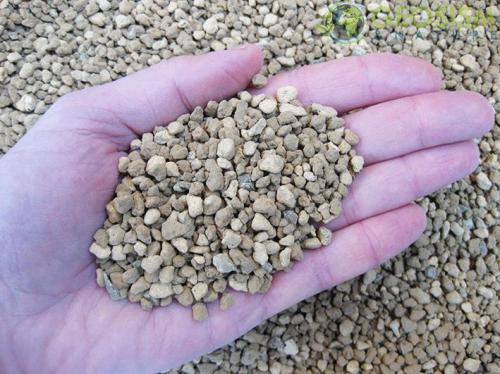Japanese professional substrate for bonsai with akadama, kiryuzuna and hyuga 2/5 mm (1 kg - about 1,4 lt)
PROFESSIONAL JAPANESE SUBSTRATE FOR BONSAI WITH AKADAMA, KIRYUZUNA AND HYUGA 2/5 mm (1 Kg - about 1.4 lt ).
This substrate (Bonsai soil) is a high quality product of Japanese origin. Made up of akadama hard quality Ibaraki triple red band, hard quality kiryuzuna and washed hyuga (pumice). Overall, it is already sieved from the dust and can be used pure without adding any other type of material.
The percentages of the three components are as follows:
? akadama hard quality triple band: 60%;
? kiryuzuna hard quality: 20%;
? washed hyuga (pumice): 20%.
Akadama is the fundamental component to create the right substrate for any type of bonsai.
Akadama literally means "Red Ball Soil" and is a clay of volcanic origin collected at a depth of 3 meters from the subsoil of Cryptomerie forests in Japan. The Akadama is collected and dried, heated to remove organisms and parasites and pulverized in different sizes.
Akadama could be used alone for each species, but I think it is reasonable for the first repottings to still use a mixture with the original soil of the plant.
Akadama can be mixed with pumice, volcanic lapillus, zeolite and perlite to make the substrate richer in nutrients and more similar to the natural characteristics in which plants live or it can be used pure as the only component of the soil.
The kiryuzuna is the fundamental component to create the right substrate for any type of bonsai obtained from conifers, such as pines and firs.
The Kiryuzuna is collected and dried, heated to remove organisms and parasites and pulverized in different sizes.
Kiryuzuna can be mixed with akadama, pumice, volcanic lapillus, zeolite and perlite to make the substrate richer in nutrients and more similar to the natural characteristics in which plants live or it can be used pure as the sole component of the soil.
Hyuga is the Japanese pumice. Pumice and lapilli are the product of explosive volcanic eruptions formed as a result of a violent expansion of gases dissolved in acidic chemical compositions: the rapid cooling of the rock prevented its crystallization, trapping the gases inside and generating minerals alveolar expanded in a more or less accentuated way.
In fact, during the solidification phase, the vapors present in the magma, suddenly released, caused the swelling of the entire mass of magma and it is during this rapid cooling phase that the differences in the physical structure of the various volcanic aggregates were determined: the volcanic lapilli it was formed from a magma with a lower silica content.
The lower viscosity and the slower cooling of the lava have facilitated the escape of a certain quantity of the gases present in the magma.
Minerals were formed characterized by emptiness with an average diameter greater than that of pumice but of a decidedly lower number.
FOLLOWING THE EVENT IN FUKUSHIMA, GEOSISM & NATURE SAS HAS DECIDED TO CHECK EVERY JAPANESE IMPORT PRODUCT RADIOMETRICALLY AND IN PARTICULAR THE SUBSTRATES AND FERTILIZERS. THEREFORE WE HAVE RADIOMETRIC CERTIFICATES THAT DOCUMENT THE NON-DANGEROUSNESS OF OUR PRODUCTS.
AVERAGE CHEMICAL ANALYSIS OF AKADAMA
Silicon (SiO2): 37.50%;
Aluminum (Al2O3): 24.46%;
Magnesium (MgO): 0.14%;
Iron (Fe2O3): 9.26%;
Calcium (CaO): 0.86%;
Manganese (MnO): 0.15%.
TECHNICAL CHARACTERISTICS OF AKADAMA
pH (H2O) : 5.01.
MEDIUM CHEMICAL ANALYSIS OF KIRYUZUNA
Silicon (SiO2): 46.88%;
Aluminum (Al2O3): 0.68%;
Magnesium (MgO): 0.17%;
Iron (Fe2O3): 7.87%;
Calcium (CaO): 1.37%;
Manganese (MnO): 0.11%.
TECHNICAL CHARACTERISTICS OF KIRYUZUNA
pH (H2O) : 6.07.
MEDIUM CHEMICAL ANALYSIS OF HYUGA (PUMICE)
Silicon (SiO2): 35.63%;
Aluminum (Al2O3): 0.20%;
Magnesium (MgO): 0.14%;
Iron (Fe2O3): 11.65%;
Calcium (CaO): 0.86%;
Manganese (MnO): 0.11%.
TECHNICAL CHARACTERISTICS OF THE HYUGA (PUMICE)
pH (H2O) : 6.91.
FUNCTIONAL CHARACTERISTICS AND FIELDS OF USE
Lightweight natural inert, ideal for:
? provides the right balance of water, air and nutrients;
? holds water for a long time without soaking the roots. When the color returns to yellowish-reddish it is time to water again;
? contains enormous quantities of minerals due to its volcanic origin.
? holds water for a long time without soaking the roots. When the color returns to yellowish-reddish it is time to water again;
? provides the right balance of water, air and nutrients;
Further tips for the right soil formula:
? drainage must vary from species to species; it is therefore important to also take into account the environmental situation in which our bonsai lives;
? the ideal soil should be aerated in the right way, so as to circulate oxygen and retain enough water to satisfy the plant's water needs between one watering and the next;
? the plants live in symbiosis with mycorrhizae. It is therefore useful to spread a veil of original earth in direct contact with the lower part of the roots;
? use all the components of the soil well dried and left to rest for a few days in the sun, eliminating parts of plants, seeds, larvae or insects.
NB: PACKAGING NEWS
It should be noted that the product will arrive inside the original packaging sealed by the Japanese manufacturer, above which Geosism & Nature sas will apply a regular label translated into the official language of the country of sale, according to the terms of the law.








